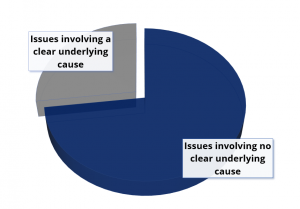
In a survey of 20 of the leading corporate infrastructure APIs, we found that in over 70% of the API problems, there was no clear root cause in the cluster of poor performance.
We used our Machine Learning system to learn the normal performance of each of the APIs. This included services from Docusign, Microsoft and Dropbox.
We looked for periods where the performance degraded. We then clustered the events that seem to be linked or related (again using machine learning techniques). Then we looked at whether or not there was a clear problem.
Our findings
In roughly 30% of the API problems we saw, there was a clear issue that other tools would identify. It was typically a server failure, or some kind of internet access-related problem.
However, in the remaining cases, we detected no apparent cause. These were significant performance degrades, where the latency of the calls decreased dramatically.
These are hard API problems to both detect and solve. Customers will notice and probably complain about such a degrade in performance. But classical monitoring tools will miss them. This lead to finger pointing between different groups in an organization or directly with customers.
When every API is a reflection of your business, you can’t afford any latency.
You don’t need excuses. You need real-time API performance data at your fingertips. We can help – find out how today.